Insect Bite Sores Treatment Advisor
Choose Your Symptom
Select the main symptom you're experiencing to get personalized treatment recommendations.
Treatment Recommendations
Select your symptom to see recommended treatments.
When to See a Doctor
Seek medical attention if you experience any of these warning signs:
- Red streaks spreading from the bite
- Increasing pain or swelling beyond the bite site
- Visible pus, foul odor, or a hole that won't close
- Fever, chills, or flu-like symptoms
- Signs of an allergic reaction: hives, swelling of lips/tongue, difficulty breathing
Ever gotten a tiny bump after a summer hike that turned into an itchy, painful sore? You’re not alone. Those irritating marks are often the result of insect bites or stings, and if you don’t know how to handle them, they can linger, scar, or even become infected. This guide walks you through smart ways to stop the problem before it starts and fast, effective steps to soothe and heal the sores when they do appear.
Key Takeaways
- Prevention starts with protecting exposed skin and avoiding high‑risk areas.
- Clean the bite immediately, then apply a cold compress to reduce swelling.
- Topical antihistamines, hydrocortisone, and calamine lotion are the most effective over‑the‑counter options.
- Watch for signs of infection-redness spreading, pus, fever-and see a clinician promptly.
- Follow a simple after‑care routine to minimize scarring and keep your skin healthy.
What Are Insect Bite Sores?
Insect bite sores is a type of skin irritation that forms after an insect bite or sting, often appearing as red, itchy bumps that can turn into painful sores if not cared for properly. The skin reaction usually stems from the insect’s saliva, venom, or a mechanical injury to the skin. Common culprits include mosquitoes, bees, wasps, ticks, ants, and even tiny midges. While most bites resolve on their own, certain factors-like scratching, allergic sensitivity, or delayed cleaning-can push a simple bump into a lingering sore.
Prevention Strategies: Stop Bites Before They Happen
Prevention is cheaper-and less painful-than treatment. Here are proven habits to keep those bugs at bay:
- Dress smart: Wear long sleeves, long pants, and tightly woven fabrics when you’re outdoors at dusk or dawn, when mosquitoes and gnats are most active.
- Use insect repellent containing DEET (20‑30%), picaridin, or oil of lemon eucalyptus on exposed skin. Re‑apply every 2‑3 hours.
- Keep windows screened and use indoor fans; many flying insects avoid breezy areas.
- Avoid scented lotions, perfumes, or brightly colored clothing that can attract bees and flies.
- Check your surroundings: remove standing water, trim tall grass, and keep your yard tidy to cut down mosquito breeding sites.
Immediate First‑Aid: What to Do Right After a Bite
Act fast to keep the bite from worsening:
- Wash the area with mild soap and cool water. This removes any remaining saliva or venom.
- Pat dry with a clean towel-rubbing can irritate the skin further.
- Apply a cold compress (a bag of frozen peas wrapped in a cloth) for 10‑15 minutes. Cold narrows blood vessels, reducing swelling and pain.
- If itching hits hard, dab on an over‑the‑counter antihistamine cream (e.g., diphenhydramine) or a hydrocortisone 1% cream.
- Avoid scratching. Scratching breaks the skin, creating a doorway for bacteria.
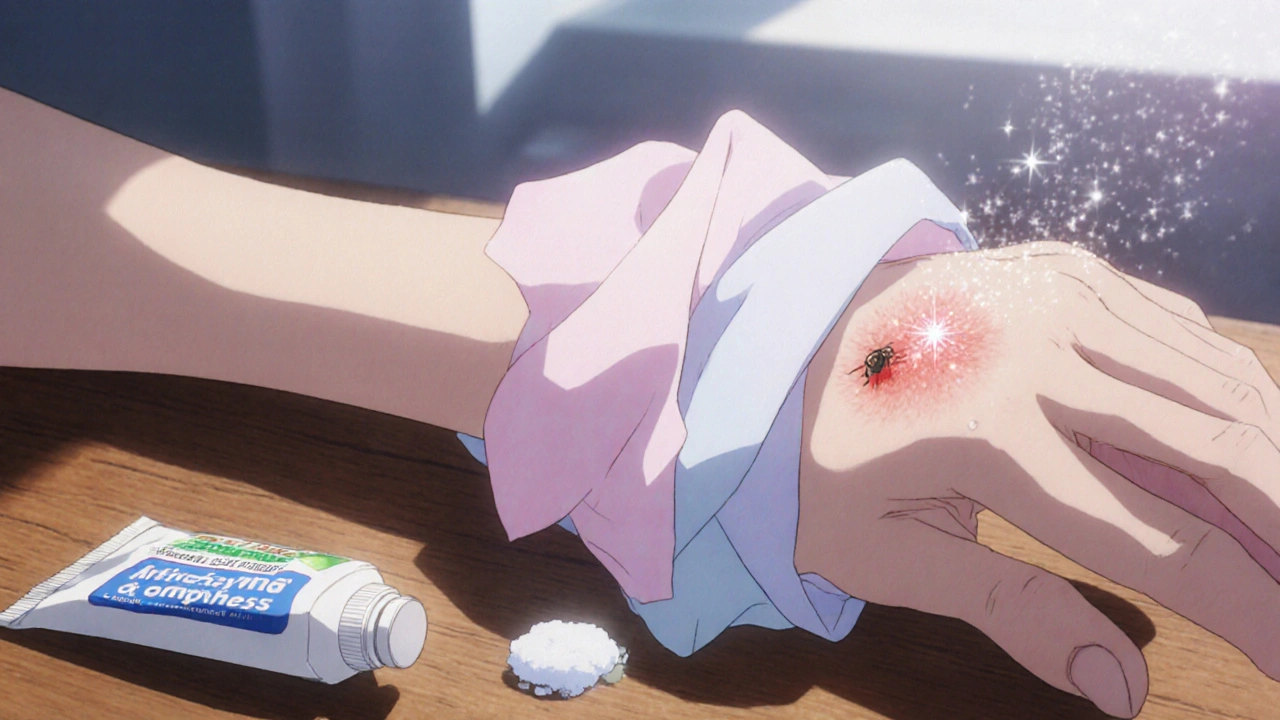
Home Treatment Options: Soothing the Sores
Most bite sores heal within a week with the right care. Below is a quick‑reference table that compares the most common topical solutions.
| Remedy | Onset of Relief | Duration of Effect | Best For | Pros | Cons |
|---|---|---|---|---|---|
| Antihistamine cream (e.g., diphenhydramine) | 5‑10 min | 2‑4 hours | Intense itching | Quick itch relief | May cause mild skin irritation |
| Hydrocortisone 1% | 10‑15 min | 4‑6 hours | Redness & swelling | Reduces inflammation | Not for broken skin |
| Calamine lotion | 15‑20 min | 3‑5 hours | Drying effect, mild itching | Soothes and dries oozing lesions | Can feel gritty |
| Honey (medical grade) | 30‑45 min | 8‑12 hours | Minor open sores | Antibacterial, promotes healing | Sticky, may attract insects |
| Oral antihistamine (e.g., cetirizine) | 30‑60 min | 24‑48 hrs | Systemic itching, multiple bites | Ease overall allergic response | May cause drowsiness |
Choose a remedy based on your primary symptom. For a single itchy bite, a dab of antihistamine cream works wonders. If the area is visibly inflamed, reach for hydrocortisone. When the bite starts to ooze, a thin layer of medical‑grade honey creates a protective barrier and speeds up healing.
When to Seek Professional Care
Most bites are harmless, but some develop complications that need a doctor’s eye:
- Rapid spreading redness (red streaks) - could signal lymphangitis.
- Increasing pain, swelling, or warmth beyond the bite site.
- Visible pus, foul odor, or a hole that won’t close.
- Fever, chills, or flu‑like symptoms - especially after a tick bite.
- Signs of an allergic reaction: hives, swelling of lips or tongue, difficulty breathing. This requires immediate emergency care.
Healthcare providers may prescribe oral antibiotics, stronger corticosteroid creams, or in rare cases, tetanus boosters.
Stings vs. Bites: Different Reactions, Same Care Principles
Stings (bees, wasps, hornets) inject venom directly, while bites (mosquitoes, ticks) usually just deposit saliva. Both can cause redness, itching, and swelling, but stings often lead to a more intense localized pain and larger welts. The treatment overlap is significant: clean, cool, and soothe. However, keep a sting‑specific tip-remove a bee stinger promptly by scraping it out with a credit card; squeezing can pump more venom into the skin.
Long‑Term Skin Care: Prevent Scarring
Even after the sore fades, you might notice a faint mark. Here’s how to keep your skin smooth:
- Apply a silicone gel sheet or scar‑reduction cream once the wound has closed.
- Massage the area gently for a few minutes daily to break down collagen bundles.
- Use sunscreen (SPF 30+) on the healed spot whenever you’re outdoors; UV exposure can darken scars.
- Stay hydrated and maintain a diet rich in vitamin C and zinc to support collagen remodeling.
Quick Reference Checklist
- Wear protective clothing and repellent before heading outdoors.
- Wash bite with soap and water immediately.
- Apply cold compress for 10‑15 minutes.
- Choose the right topical: antihistamine for itch, hydrocortisone for swelling, honey for open sores.
- Monitor for infection signs; see a doctor if they appear.
- After healing, protect the spot with silicone gel and sunscreen.
Frequently Asked Questions
Can I use toothpaste on an insect bite sore?
Toothpaste may dry out the bite, but it also contains abrasives and flavoring agents that can irritate the skin further. A better option is a clean, cool compress followed by a proven topical like hydrocortisone or calamine.
How long should I wait before applying a cold compress?
Apply the cold compress within the first 5‑10 minutes after the bite. Early cooling helps limit the histamine response and reduces swelling.
Are there any natural remedies that work as well as over‑the‑counter creams?
Medical‑grade honey and aloe vera gel have solid evidence for soothing and antibacterial properties. They can be as effective as hydrocortisone for mild inflammation when used consistently.
What should I do if I develop a fever after a tick bite?
A fever after a tick bite could indicate Lyme disease or another tick‑borne infection. Seek medical attention immediately; early antibiotics are crucial.
Is it safe to scratch a bite sore if it’s really itchy?
Scratching breaks the skin barrier and invites bacteria, turning a simple itch into an infection. Use an antihistamine cream or a cold compress to calm the itch instead.
By following these prevention tips and treatment steps, you can keep those pesky bite sores from ruining your outdoor fun. Remember, the key is swift cleaning, smart soothing, and staying alert for any signs of trouble.
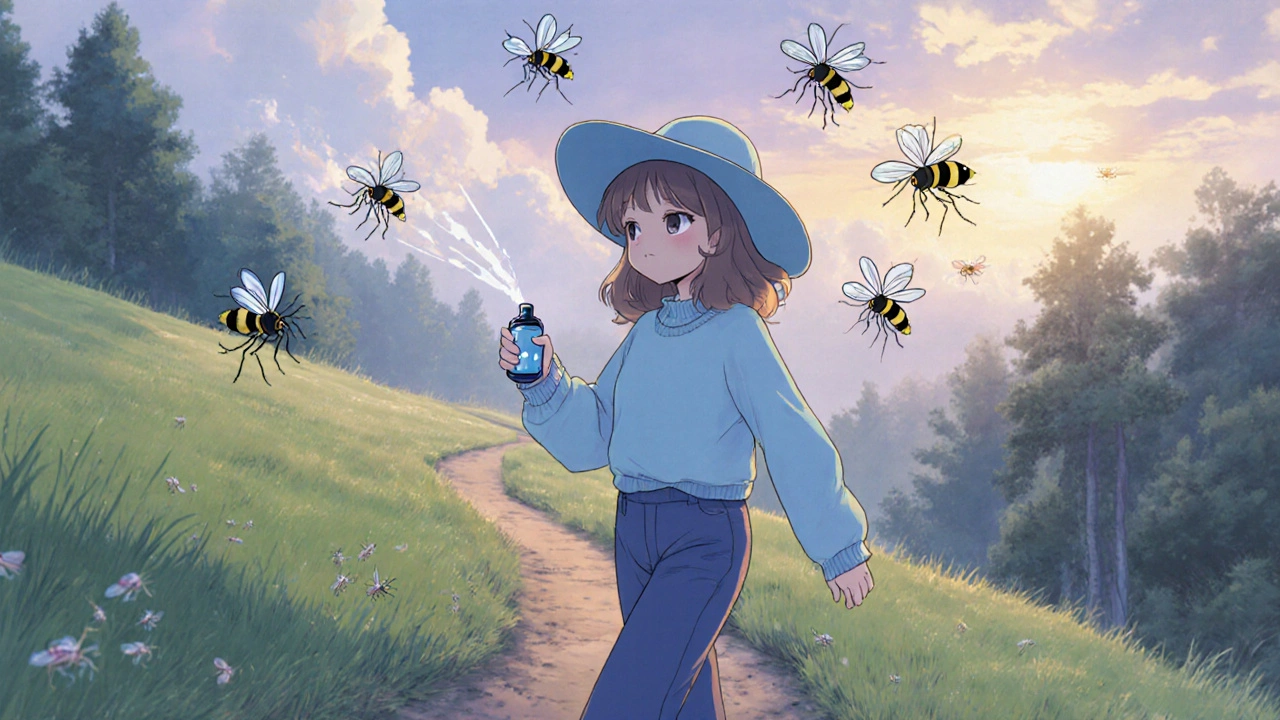
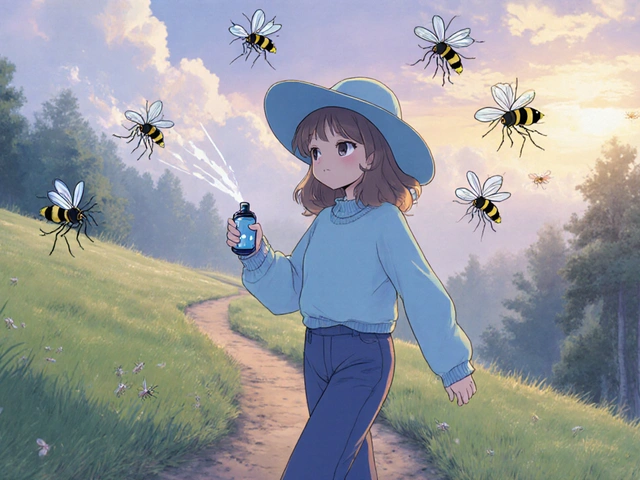

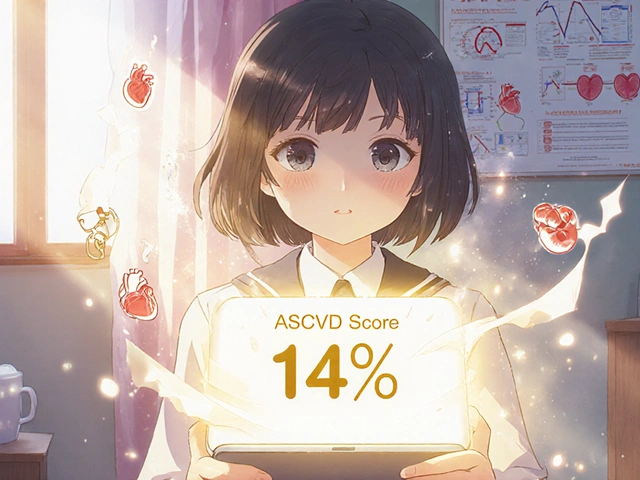
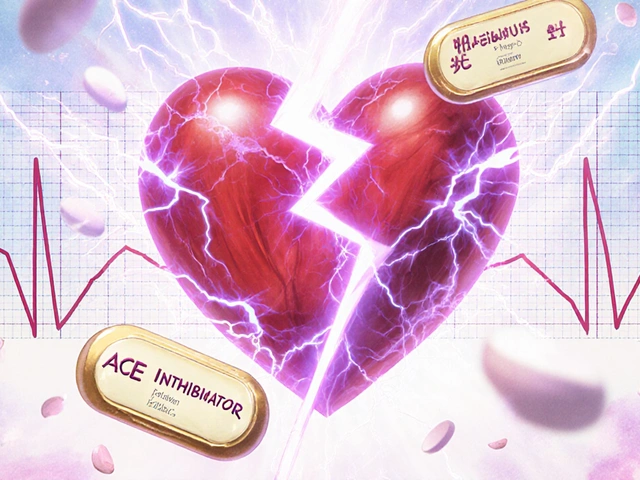

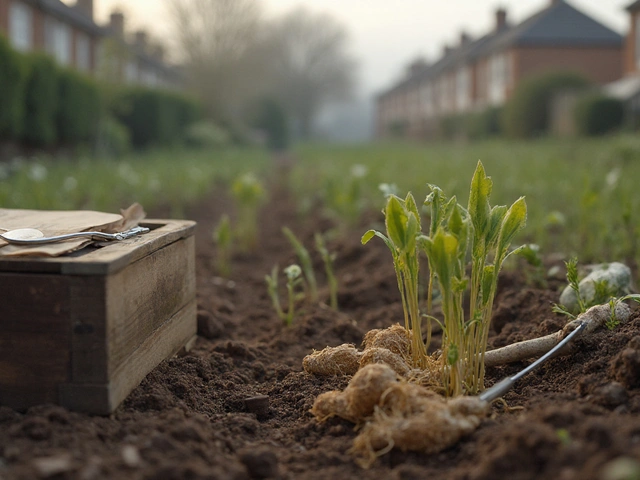

Chirag Muthoo October 20, 2025
Thank you for compiling such a thorough guide; the structured approach makes it easy to follow. I appreciate the emphasis on early cleaning and the clear warning signs of infection. It is reassuring to see practical tips presented without needless hype. Best wishes for safe hikes ahead.
Harry Bhullar November 9, 2025
When you’re out in the field and a mosquito decides to leave its mark, the first thing you should do is wash the bite with mild soap and cool water to remove any lingering saliva.
That simple step cuts down the amount of irritant that can stay on the skin and reduces the chance of a secondary infection.
After washing, gently pat the area dry with a clean towel; rubbing will only aggravate the skin and spread inflammation.
Next, apply a cold compress-think a bag of frozen peas wrapped in a thin cloth-for ten to fifteen minutes, which constricts blood vessels and tampers down swelling.
If the itch is driving you nuts, a thin layer of over‑the‑counter antihistamine cream such as diphenhydramine works quickly, usually within five to ten minutes.
For more pronounced redness or swelling, a 1 % hydrocortisone cream is the next logical step, providing anti‑inflammatory action that lasts several hours.
When the bite starts to ooze, consider a medical‑grade honey dressing; it creates a sterile barrier and has natural antibacterial properties that speed healing.
Keep an eye on the lesion for any signs of infection-spreading redness, increasing warmth, pus, or fever are red flags that warrant professional attention.
Should any of those symptoms appear, a visit to your primary care provider is advisable; they may prescribe oral antibiotics or a stronger corticosteroid.
In the meantime, avoid scratching at all costs because broken skin is a prime entry point for bacteria.
If you’re planning a multi‑day trek, reapply your insect repellent every two to three hours, especially after sweating or swimming.
DEET concentrations of 20‑30 % are effective, but if you prefer a plant‑based alternative, oil of lemon eucalyptus can offer comparable protection.
Dress in tightly woven, long‑sleeved clothing, and consider treating your garments with permethrin for added defense.
Removing standing water around your campsite and keeping grass trimmed reduces the local mosquito population, lowering the overall bite risk.
Should you encounter a bee or wasp sting, remember to scrape the stinger out with a credit card rather than pinching it, which can inject more venom.
Finally, after the bite has healed, protect the new skin with a silicone gel sheet or scar‑reduction cream and apply SPF 30+ sunscreen to prevent hyperpigmentation.
By following these steps, you’ll minimize discomfort, prevent infection, and keep your outdoor adventures itch‑free.
Dana Yonce November 28, 2025
Great tips, I’ll try the honey trick next time :)
Lolita Gaela December 17, 2025
The utilization of topical corticosteroids modulates the NF‑κB signaling cascade, thereby attenuating the transcription of pro‑inflammatory cytokines such as IL‑1β and TNF‑α.
Antihistamine creams act as H1‑receptor antagonists, providing rapid pruritus relief through blockade of histamine-mediated neuronal firing.
Medical‑grade honey exhibits broad‑spectrum bactericidal activity via osmotic pressure and hydrogen peroxide generation, which is especially beneficial for partially compromised epidermis.
When applied in a thin film, calamine lotion provides astringent properties that desiccate exudate while offering a soothing, cooling sensation.
For systemic symptomatology, oral cetirizine offers a once‑daily dosing regimen with a half‑life conducive to sustained antihistaminic effect.